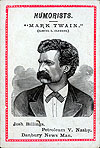
| Below: Illustration of Mark Twain from Life magazine (13 July 1905), special color insert; Clifton Waller Barrett Library of American Literature, Papers of Mark Twain (MSS 6314). |

|
The assignment I gave the graduate students enrolled in the seminar "Mark Twain in His Times" was this: to create an exhibit of materials from Special Collections that would explore Twain's significance for America -- the nation that made him the first American idol. They took it from there. The resulting exhibit -- drawn largely from the Clifton Waller Barrett Library of American Literature -- focuses on the relationship between the nation's culture and Twain's achievements during the lifetime of Samuel Clemens (1835 - 1910), the man behind the pen name. Each student has identified a pair of items that manifests the ways the author's imagination and the preoccupations of American culture symbiotically affected one another. — Stephen Railton |
|
| |
  |
From 1861 to 1867, during the rush for silver, Mark Twain lived in the Nevada Territory and elsewhere in the American West. These experiences served as the impetus for Roughing It, his second travel narrative. In this 1862 letter to his brother, Twain sketched the mining country in Esmeralda, Nevada, much as a surveyor might. In a U.S. government report on "the most practicable route for the railroad," a survey drawing depicts California, where tracks for the Central Pacific Railroad began to be laid in 1863. By the time Twain published Roughing It in 1872, the railroad had been completed, having paved the way for American "progress." — Audrey Golden Top: Letter from Mark Twain to Orion Clemens, 22 June 1862. Clifton Waller Barrett Library of American Literature, Papers of Mark Twain (MSS 6314) REST OF LETTER – PAGE 2 | PAGE 3 | PAGE 4 Bottom: Survey drawing from Reports of explorations and surveys to ascertain the most practicable and economical route for a railroad from the Mississippi River to the Pacific Ocean (Washington, D.C.: B. Tucker, 1855-1860), vol. 7 (F593. U58 1855b) |
|
| |
|
| |
 
|
Billed as "an amusing and instructive pastime," the Portrait Artists Card Game contains thirty-two pairs of cards - one displays a picture of the author and the other a matching biography. Mark Twain is categorized as a humorist. His biographical card mentions his early journalism career and lists recent works, including "The Jumping Frog of Calaveras County," Innocents Abroad, Roughing It, and The Gilded Age. The card also notes Twain's 1873 lectures in London and refers to his growing international status. After a decade-long hiatus, Twain re-embarked on the lecture circuit with friend and fellow writer, George Washington Cable, in order to promote his forthcoming novel, Adventures of Huckleberry Finn. The two writers performed in eighty cities across the United States and Canada in 1884-1885. During the tour, Cable suggested to Twain that he read Thomas Malory's Le Morte d'Arthur, which later influenced Twain's writing of A Connecticut Yankee in King Arthur's Court. — Lisa McGunigal Top: Portrait Artists Card Game, 1873. Clifton Waller Barrett Library of American Literature (PS138 .P67) BACK OF CARD | GAME BOX COVER Bottom: Signed Publicity Photograph for the 1884-1885 Lecture Tour. Clifton Waller Barrett Library of American Literature (MSS 6314) |
|
| |